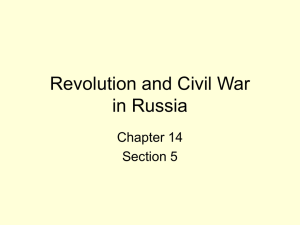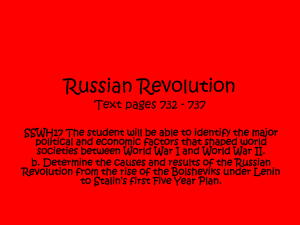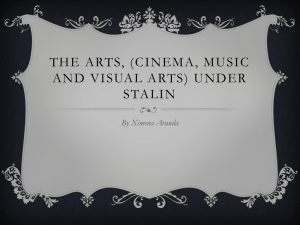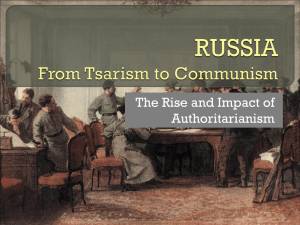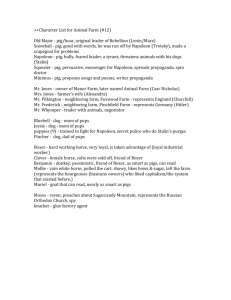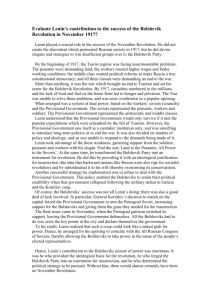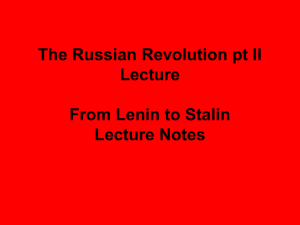Russia Revision
advertisement
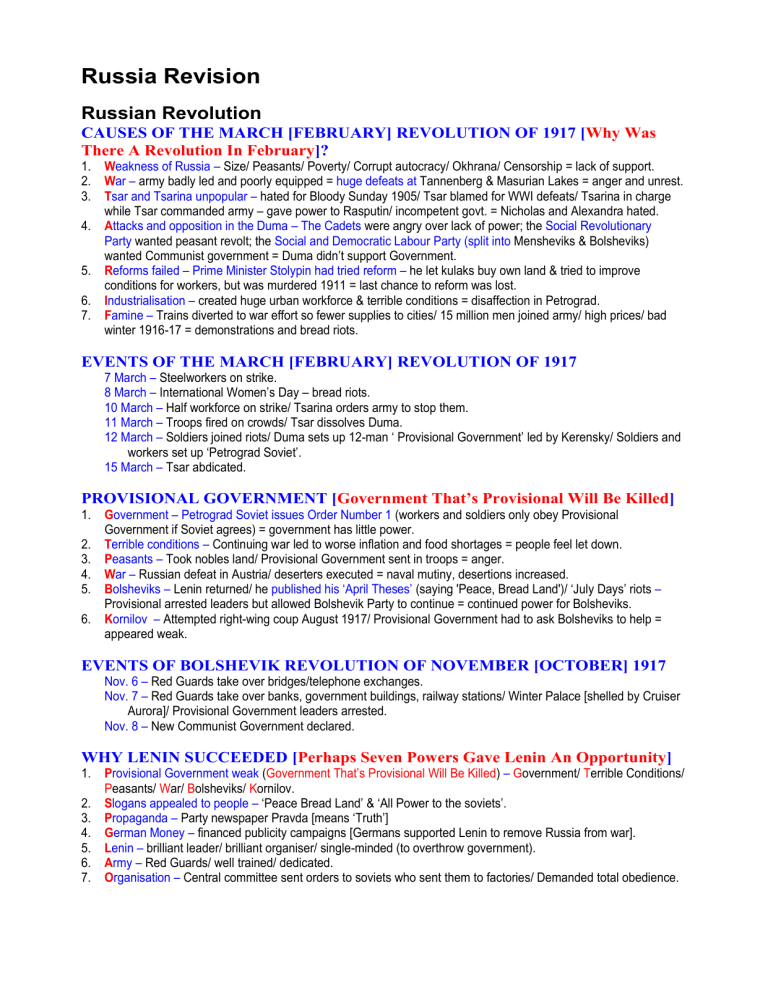
Russia Revision Russian Revolution CAUSES OF THE MARCH [FEBRUARY] REVOLUTION OF 1917 [Why Was There A Revolution In February]? 1. Weakness of Russia – Size/ Peasants/ Poverty/ Corrupt autocracy/ Okhrana/ Censorship = lack of support. 2. War – army badly led and poorly equipped = huge defeats at Tannenberg & Masurian Lakes = anger and unrest. 3. Tsar and Tsarina unpopular – hated for Bloody Sunday 1905/ Tsar blamed for WWI defeats/ Tsarina in charge while Tsar commanded army – gave power to Rasputin/ incompetent govt. = Nicholas and Alexandra hated. 4. Attacks and opposition in the Duma – The Cadets were angry over lack of power; the Social Revolutionary Party wanted peasant revolt; the Social and Democratic Labour Party (split into Mensheviks & Bolsheviks) wanted Communist government = Duma didn’t support Government. 5. Reforms failed – Prime Minister Stolypin had tried reform – he let kulaks buy own land & tried to improve conditions for workers, but was murdered 1911 = last chance to reform was lost. 6. Industrialisation – created huge urban workforce & terrible conditions = disaffection in Petrograd. 7. Famine – Trains diverted to war effort so fewer supplies to cities/ 15 million men joined army/ high prices/ bad winter 1916-17 = demonstrations and bread riots. EVENTS OF THE MARCH [FEBRUARY] REVOLUTION OF 1917 7 March – Steelworkers on strike. 8 March – International Women’s Day – bread riots. 10 March – Half workforce on strike/ Tsarina orders army to stop them. 11 March – Troops fired on crowds/ Tsar dissolves Duma. 12 March – Soldiers joined riots/ Duma sets up 12-man ‘ Provisional Government’ led by Kerensky/ Soldiers and workers set up ‘Petrograd Soviet’. 15 March – Tsar abdicated. PROVISIONAL GOVERNMENT [Government That’s Provisional Will Be Killed] 1. Government – Petrograd Soviet issues Order Number 1 (workers and soldiers only obey Provisional Government if Soviet agrees) = government has little power. 2. Terrible conditions – Continuing war led to worse inflation and food shortages = people feel let down. 3. Peasants – Took nobles land/ Provisional Government sent in troops = anger. 4. War – Russian defeat in Austria/ deserters executed = naval mutiny, desertions increased. 5. Bolsheviks – Lenin returned/ he published his ‘April Theses’ (saying 'Peace, Bread Land')/ ‘July Days’ riots – Provisional arrested leaders but allowed Bolshevik Party to continue = continued power for Bolsheviks. 6. Kornilov – Attempted right-wing coup August 1917/ Provisional Government had to ask Bolsheviks to help = appeared weak. EVENTS OF BOLSHEVIK REVOLUTION OF NOVEMBER [OCTOBER] 1917 Nov. 6 – Red Guards take over bridges/telephone exchanges. Nov. 7 – Red Guards take over banks, government buildings, railway stations/ Winter Palace [shelled by Cruiser Aurora]/ Provisional Government leaders arrested. Nov. 8 – New Communist Government declared. WHY LENIN SUCCEEDED [Perhaps Seven Powers Gave Lenin An Opportunity] 1. Provisional Government weak (Government That’s Provisional Will Be Killed) – Government/ Terrible Conditions/ Peasants/ War/ Bolsheviks/ Kornilov. 2. Slogans appealed to people – ‘Peace Bread Land’ & ‘All Power to the soviets’. 3. Propaganda – Party newspaper Pravda [means ‘Truth’] 4. German Money – financed publicity campaigns [Germans supported Lenin to remove Russia from war]. 5. Lenin – brilliant leader/ brilliant organiser/ single-minded (to overthrow government). 6. Army – Red Guards/ well trained/ dedicated. 7. Organisation – Central committee sent orders to soviets who sent them to factories/ Demanded total obedience. Lenin's Russia ESTABLISHING COMMUNIST RULE [Great Big Changes Create Terrible War] 1. Government changes – election Nov. 1917 results: Bolshevik=175 seats, Social Revolutionaries = 370 seats 2. Lenin – closed Assembly/ killed objectors/ ruled by decree. 3. Brest-Litovsk – Bolsheviks ended war 1917/ Treaty gave good agricultural and industrial land to Germany. Russia lost – Ukraine, Estonia, Latvia & Lithuania. 4. Communist state – Land taken from nobles & given to peasants/ Elected committees of workers controlled factories. 5. Communist society – Religion banned (= churches destroyed, priests killed)/ Labour Law (= 8 hour day, unemployment pay & pensions)/ Education (= Science encouraged, History and Latin banned & people taught to read)/ Communist morals (= Divorce allowed, abortion allowed & greater equality for women). 6. Terror – Totalitarian state/ CHEKA [secret police] arrested and killed opponents/ Censorship/ Lenin said a ‘Dictatorship of the Proletariat’ was needed until Russia was fully Communist. 7. War Communism – introduced during Civil War, very harsh (Large factories taken over by government, strikes illegal 8. strikers shot, rationing & peasants forced to give surplus food to government). CAUSES OF THE CIVIL WAR [Causes Civil War] 1. Challenge to Bolsheviks from Political opponents -- Social Revolutionaries, Mensheviks, Tsarists, former army officers, former landlords, ‘White’ armies led by generals Yudenich and Deniken attacked from west, Admiral Kolchak attacked from east. 2. Czech Legion – prisoners of war mutinied as they were being taken across Russia, took control of Trans Siberian railway & supported Kolchak. 3. World Revolution – Comintern set up with stated aim to cause communist revolutions across the world, so, frightened, Britain, America, France supported ‘whites’ against Bolsheviks. EVENTS OF THE CIVIL WAR 1918–1921 Famine, disease and atrocities throughout/ millions died. 1918 – Tsar and family put to death 1919 – Red Army defeated Admiral Kolchak/ British, French, Americans went home. 1920 – Last White army defeated in Crimea. 1921 – Red Army invaded Poland, but was defeated WHY THE BOLSHEVIKS WON [Why The Bolsheviks Won The War] 1. Whites' armies – Were disunited/ Thousands of miles apart = easy to fight one by one. 2. Trotsky – brilliant leader of Red Army/ excellent war strategist = clever tactics. 3. Beliefs – Many Russians believed they were fighting for a better world/ others hated foreign armies = army enthusiastic and determined. 4. War Communism – factories nationalised/ military discipline in factories/ strikes illegal/ Surplus food handed over to government/ rationing = sufficient army supplies. 5. Terror – Cheka murdered Whites/ terror was used to ensure loyalty and unity. 6. Wherewithal – Bolsheviks held Moscow/Petrograd = factories/supplies ALSO Controlled railways = communication/supplies ALSO Army of 300,000 men. THE NEW ECONOMIC POLICY 1. Cause – 1921 Kronstadt Mutiny: Sailors at Kronstadt naval mutinied –demanded free speech, free elections, free trade unions, end to War Communism. 2. The Bolsheviks concerned, brought in NEP – It was opposed by some members of government as capitalism, but it restored some prosperity. 3. The New Economic Policy (NEP) New Small businesses – Small factories returned to owners/ small private businesses allowed. Experts – brought in to increase production in nationalised industries (coal, iron, steel & railways). Peasants – allowed to sell surplus and pay tax; Some peasants became rich [the Kulaks]. Stalin's Russia STRUGGLE FOR POWER AFTER LENIN DIED IN 1924 [Stalin Takes Power] 1. Secretary – as General Secretary of Com. Party installed supporters in important positions. 2. Trotsky unpopular – brilliant but big-headed/ Missed Lenin’s funeral (Stalin told him wrong date)/ Ideas of world revolution worried some Russians - too soon. 3. Played off 2 sides of Politburo against each other: First Stalin allied with Zinoviev and Kamenev [Leftists] = got Trotsky dismissed 1925. Next he called for ‘Socialism in one country’, allied with Bukharin, Rykov and Tomsky [Rightists] = got Zinoviev and Kamenev dismissed 1927. Then he said the NEP wasn’t socialist = got supporters of it [Bukharin, Rykov, Tomsky] dismissed 1929. STALIN'S TERROR THE PURGES (Stalin Takes Total Control) 1. Secret police – The Cheka became OGPU in 1924/ became NKVD in 1934. 2. The First Purges 1930-1933 – anyone who opposed industrialisation or who opposed collectivisation. 3. The Great Purges 1934-1939 – triggered by murder of Kirov Political Opponents – thousands arrested/found guilty of treason at ‘Show trials’ – e.g. Zinoviev/ Kamenev 1936, Bukharin/ Tomsky/ Rykov 1938 Army – Commander-in-Chief of Red Army shot/ many other generals admirals & officers executed or imprisoned Church – leaders imprisoned/ churches closed Ethnic groups – ‘Russification’/ mosques closed Ordinary people – arrested, sent to Gulag [labour camps]/ 20m died/ Apparatchiks [supporters] got new homes. 4. Cult of Stalin – pictures/ statues/ constant applause/ history books changed REASONS FOR THE PURGES (Why Unnecessary Purges?) 1. Whole country – belief in ‘strength in unity’. 2. Urgency – Stalin said Russia had 10 years to catch up the west before Germany invaded 3. Paranoia – Stalin saw plots everywhere and became power-mad. RESULTS (Results Of The Terror – Insane Stalin Grabs All The Power) Russification/ Orthodox Church attacked/ Twenty million dead/ Terror & fear/ Industry-affected by loss of top scientists & engineers/ Stalin cult/ Gulag/ Army and navy lost leading officers/ Purges COLLECTIVISATION WHY? [Six Factors Now To Collectivise Kolkhoz] 1. Soviet agriculture backward – subsistence farming/ no machinery/ too small/ inefficient. 2. Food was needed for workers in towns – essential for success of 5 year plans 3. NEP not working – by 1928, 20 million tons of grain short to feed towns. 4. Town workers were needed – peasants needed to work in industry in towns. 5. Cash crops were needed – for export to raise money to buy foreign machinery and expertise. 6. Kulaks – not Communists/ had private wealth/ Stalin wanted to destroy them. ENFORCEMENT (5 key dates): 1927 – voluntary scheme ignored = food shortages 1929 – compulsory collectivisation/ peasants burned crops = famine 1932– 33 – two-thirds of villages collectivised/ more resistance/ government took food for towns = more famine [5m died in Kazakstan & Ukraine]. Stalin blamed Kulaks = shot/ to labour camps in Siberia/ land taken. 1934 – all 7 million Kulaks ‘eliminated’ 1939 – 99% of land collectivised/ ¼ million Kolkhoz. RESULTS [Quite Modern Govt Technology Encourages Collectivisation - Poor Foolish Kulaks] Quarter of million Kolkhoz / More modern methods – machinery, modern farming methods & ideas, large-scale/ Grain – by 1937, 97 million tons plus cash crops/ Town workers – 17 million peasants moved to work in towns/ End of nobles/ Complete Communist control BUT Production fell at first/ Famine/ Kulaks destroyed INDUSTRIALISATION REASONS (Make And Catch Up) 1. Many regions of the USSR were backward/ Machinery was needed to mechanise agriculture 2. Armaments – would be needed to defend Russia. Stalin believed Germany would invade: ‘Either we make good the difference in 10 years or they crush us’. 3. Compete with Western world – Stalin believed the USSR should ‘overtake the capitalist countries’ (‘Socialism in one country’) then the USSR would take over the rest of the world. 4. Useful propaganda for Communism and for Stalin. 5 YEAR PLANS 1928 – 32 – heavy industry 1933 – 37 – agricultural machinery + mining, transport The Plans – Targets set by GOSPLAN for every industry/ Foreign experts brought in/ Propaganda (Posters, Slogans, Bonuses, encouraged to be Stakhanovites)/ Fines for not meeting targets/ Women encouraged to work (Crèches set up – 1932-37 4 out 5 new workers recruited were women)/ Slave labour used/ Education and training/ Harsh conditions/ Industry not consumer goods. SUCCESSES 1. The USSR was turned into a modern state/ there was genuine Communist enthusiasm among the young ‘Pioneers’. 2. Huge increases in production, 1927–37 (Electricity up 5–36,000m kw/ Coal up 35–128m tons/ Steel up 4–18m tons) 3. Many achievements – new cities, dam/ hydroelectric power, transport & communications, the Moscow Underground, farm machinery, electricity, coal, steel, fertilisers, plastic, no unemployment, doctors & medicine, education. FAILURES/CRITICISMS 1. Poorly organised – Inefficiency/ duplication of effort/ waste. 2. Appalling human cost – discipline (sacked if late)/ secret police/ slave labour/ labour camps (for those who made mistakes)/ accidents & deaths (100000 workers died building the Belomor Canal)/ few consumer goods/ poor housing/ wages FELL/ no human rights. 3. Some historians claim the tsars set up the basis for industrialisation.
